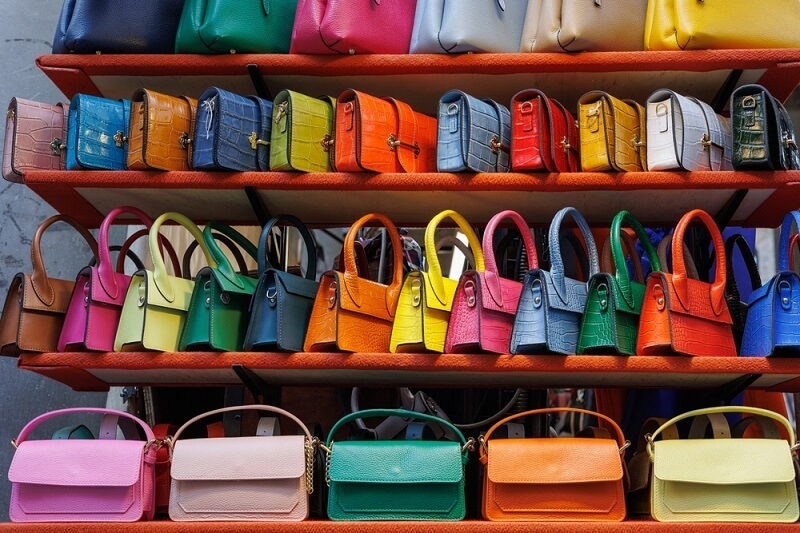A Beginner’s Guide to Leather Handbag Types and Quality

Handbags are more than just an accessory. Handbags are our everyday companions, a representation of individuality, and potential investments in the future. Leather handbags have been around for centuries, representing durability, craftsmanship, and sophistication. But for a beginner, the differences between types of leather handbags, with all the types we are faced with, can be overwhelming. Full-grain leather bags, top-grain leather purses, and genuine leather handbag guides appear regularly in descriptions, but what exactly does that mean?
This beginner's guide will help you understand the types of leather handbags, how to assess quality, and the best leather purse materials. Whether searching for your first luxury handbag or curious about the differences, this article will walk you through the steps.
Why Leather Handbags Are Considered Timeless
Before we wade into the details, knowing why leather has dominated handbags for thousands of years is essential.
- Durability: Leather, especially high-quality leather, can withstand continuous use for years and still look great.
- Beautiful Aging: Real leather ages beautifully, while synthetic materials do not age as well.
- Ambiance of Luxury: Nothing feels, looks, or smells like leather. Leather is associated with richness and prestige.
- Craftsmanship: Many things are made by hand from leather, making every handbag unique.
Not all leather is equal. Understanding the differences among full-grain, top-grain, genuine leather, and other handbag types is essential to ensuring you make the proper investment.
Understanding Leather Grades and Qualities
Leather handbags generally fall into four main categories. Each type differs in feel, appearance, and durability.
1. Full-Grain Leather Bags
- Definition: Full-grain leather is made from the top layer of hide. It retains the natural texture and imperfections of animal skin.
- Qualities: This type of leather is the strongest and will last the longest. Over time, full-grain leather develops a unique patina that befits its beauty.
- Best for: Luxury handbags, heirlooms, and those who prefer an actual leather experience.
- Pros: Extremely durable, ages well, and the grain pattern will be unique.
- Cons: More expensive and heavier than other types.
2. Top-Grain Leather Purses
- Definition: Top-grain leather is sanded or buffed to eliminate flaws, giving it a nicer and more uniform surface than full-grain leather.
- Qualities: It is more flexible and lighter weight, making it one of the most common leather choices for handbags.
- Best For: Everyday purses and trendy handbags where durability and softness have a good balance.
- Pros: Softer hand, less expensive than full-grain leather, and easy to maintain.
- Cons: Not as durable as full-grain leather and loses some natural character.
3. Genuine Leather Handbag Guide
- Definition: Ironically, although "genuine leather" sounds appealing, it refers to the lesser levels of the hide that have been processed and treated.
- Qualities: It is genuine leather, just not of the same quality as higher grades.
- Best For: Fashion-oriented shoppers prefer a cheaper substitute for higher-quality leather handbags.
- Pros: Cheaper prices with more styles and options.
- Cons: Does not wear as well, is not durable, and wears out faster.
4. Bonded Leather
- Definition: Made from the leather leftovers from the above processes, bonded with polyurethane or some glue.
- Qualities: They are not of excellent quality, but mostly made for cheap bags.
- Best For: Short-term or on-trend handbags.
- Pros: Very cheap, readily available.
- Cons: Short life, cracks easily, lacks realism.
Different Leather Handbag Types by Design

Leather handbags come in many styles, each suited for different occasions and needs. Beginners should understand leather quality and handbag type to make the best choice.
1. Tote Bags
- Spacious and versatile, totes are perfect for work or shopping. Full-grain or top-grain leather totes offer both durability and elegance.
2. Crossbody Bags
- Lightweight and functional, crossbodies made of top-grain leather balance comfort with chic appeal.
3. Satchels
- Structured handbags are often chosen for professional settings. Full-grain satchels convey sophistication.
4. Shoulder Bags
- Timeless designs that suit both casual and formal wear. Top-grain leather purses dominate this category.
5. Clutches
- Evening essentials. Genuine or top-grain leather clutches bring a sleek finishing touch.
6. Backpacks
- Leather backpacks combine practicality with luxury. Full-grain versions last for years and are excellent for travel.
How to Identify the Best Leather Purse Materials
There is more to picking a good leather purse than just the label. Here are some considerations to determine a purse's quality:
- Texture: Full-grain leather feels more natural, whereas fake or bonded leathers often feel unnaturally smooth.
- Smell: Real leather has a distinct earthy smell that is much different from synthetic or odd chemical smells.
- Flexibility: Quality leather will bend easily without cracking.
- Weight: Leather handbags will feel heavy compared to fake leather bags.
- Price Point: Higher quality leathers tend to be more expensive; this is not a rule, but it generally is the case.
Caring for Leather Handbags
Proper care is essential for maintaining your leather handbag's long-term beauty and longevity.
- Regular cleaning: Use a soft cloth (not wet) and water—no abrasives!!
- Conditioning: Condition with leather conditioner to avoid drying and cracking
- Storage: If you store handbags, store them in dust bags away from sunlight and humidity.
- Don't overload: Carrying more than what a handbag is designed for will stretch the hardware, deform the handbag, and overheat the handles.
- Rotate use: Allow your handbags to have a downtime and rotate use to keep the artistry and finished product.
Leather Alternatives and Sustainability
While this guide is primarily about genuine leather, it is essential to recognize that more sustainable alternatives to leather are becoming available. Many brands produce eco-friendly and vegan leathers, allowing consumers to buy stylish, ethical options. But if you love the real experience of leather, then you should be able to discover the types of leather and assess their quality.
How to Choose Your First Leather Handbag
If you're a newbie purchasing leather handbags, here is an easy-to-follow plan of action:
- Set a Budget: First, you must determine whether you want an heirloom-quality full-grain leather bag or an inexpensive genuine leather handbag.
- Choose a Style: Decide how you tend to carry handbags regularly. For example, do you mostly carry tote bags, satchels/purses, crossbody bags, etc.
- Check Quality: Check the grade of leather, the stitching, the lining, and the hardware.
- Think About Longevity: Generally, classic full-grain or top-grain leather handbags will last longer and remain stylish.
- Start neutral: Newbies typically benefit from starting with classic colors such as black, brown, or tan, which provide the most versatility.
Common Myths About Leather Handbags
Myth #1: Genuine leather is the highest quality.
Truth: Genuine leather is the lowest quality compared to top-grain and full-grain leather.
Myth #2: Expensive = Better.
Truth: Price does not always equal quality. Brand names certainly affect price.
Myth #3: Leather is rugged to take care of.
Truth: Quality leather handbags will last, in some cases, decades with minimal care.
Myth #4: All leather looks the same.
Truth: Grain patterns, finishes, and patinas give the leather uniqueness.
Final Thoughts
When starting your journey into leather handbags, you'll likely notice that it can feel like a complicated world. However, if you know the fundamentals of the types of leather bags on the market and how to assess the quality, you will have the perfect starting point. From the sturdiness of full-grain leather bags to the refined top-grain leather purses to affordable genuine leather, each will have its role in fashion.
Ultimately, you must make the call based on your preference, budget, and lifestyle. If you want durability and elegance, you should spend the money on full-grain leather. If you want a bag for day-to-day wear where comfort is more important, go with a top-grain bag. If you want to look fashionable and pay an affordable price, using genuine leather is more than acceptable.
Once you have a good knowledge of the best leather purse materials and a commitment to craftsmanship, you can make a better purchase and enjoy the enduring beauty of leather handbags for years
This content was created by AI

